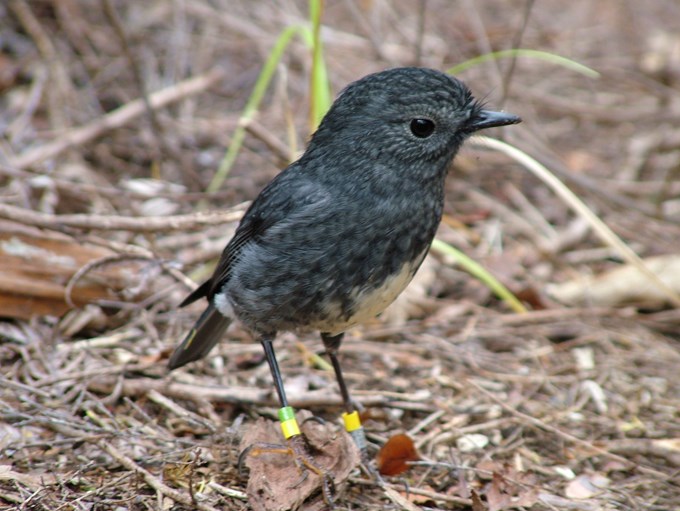With dwindling populations in the North Island, toutouwai (North Island robins) have had various translocation efforts over the past 20 years to Aotea / Great Barrier in the hope that their population would thrive in the protected release areas. While these translocation outcomes have been unsuccessful in these release areas, there have been consistent sightings of toutouwai since 2007 on Hirakimata, the highest point on Aotea.
Two years ago, the Aotea / Great Barrier Local Board approved a grant to the Windy Hill Rosalie Bay Catchment Trust to contract bird man Dr Kevin Parker to band some of these birds so data could start to be collected on how well the cheeky toutouwai were faring on the maunga.
“The board was very pleased to be able to allocate the initial funding to Windy Hill Rosalie Bay Catchment Trust to undertake this project to determine how the toutouwai were faring,” says Local Board chairperson Izzy Fordham.
“We are delighted with Dr Parker’s initial thoughts and sightings, and we look forward to the follow up work that will hopefully show us that there is a strong and healthy colony of these cheeky little characters on Aotea.”
After two years of delay due to Covid, Kevin finally spent four nights in late March on Hirakimata to lure, trap and band birds with their unique identification leg bands.
20 birds were encountered during the four-day survey, with 12 of these birds captured and banded. All birds appeared healthy and in good condition.
Based at the DOC research hut just off Kaiaraara Track, Kevin walked the main tracks, playing toutouwai calls and looking and listening for birds.
When a toutouwai was located, its location was recorded on GPS, and the bird was fed mealworms. Potter Traps were used to attempt to catch the birds, using mealworms as bait. Captured birds were weighed and banded. An individual four band combination was placed on each bird, consisting of a numbered metal band on the lower right leg, and three plastic colour bands (two on the left, one on the right). Measurements were taken to determine the sex of each captured bird, and they were given a brief physical examination to assess general health and condition, before being released at the site of capture.
Birds that were shy and reluctant to approach the trap were fed and the location recorded. As a result, when they were revisited the next day they were usually captured. When toutouwai were heard at a distance in difficult or inaccessible locations, an approximate location was noted on a map of the area.
The overall population of toutouwai on Hirakimata is expected to be larger than 20, as females tend to be harder to find, and juveniles are often shyer of humans. The combination of a colder and wetter climate at elevation on Hirakimata, along with cat and rat control likely affords some protection to the small toutouwai population.
We can all help to monitor the toutouwai population! If you see a toutouwai on Aotea please record the bands if they are present, take a photo if you can, and send the information to lovebirds@xtra.co.nz


